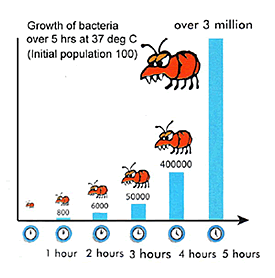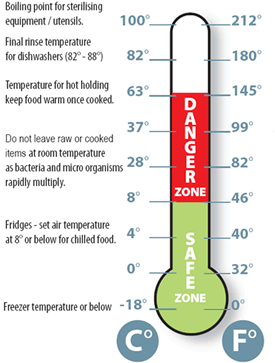| BlueSky Business Aviation News | ||||||||||||||||||||||||
| . | ||||||||||||||||||||||||
Restaurants are referred to as a cook-serve environment which means that they cook, plate, and serve the food to be eaten immediately. Even if this food is ordered as take out, the assumption from the restaurant is it's going to be eaten in a very short period of time, actually before the food cools off. A restaurant’s liability ends when the food leaves their premises. An aviation caterer is different. We are considered cook-chill environments. We cook the food, planning for and understanding that it will be transported and reheated at a later time; thus the chill portion of our name. This is a huge difference! Everyone responsible for ordering or receiving food from a restaurant, whether in small town USA or in Moscow, should understand several important points . When I work with new staff in our kitchen or train a new caterer in aviation catering, I always teach the ” why” in why I do things a certain way. I want them to understand that it is not because I am some compulsive person who goes berserk if the stem end of the strawberry isn’t facing up. I want them to be able to recognize potential hazards in future situations. Temperature is at the top of the list of safety concerns when ordering from a restaurant.
Because most restaurants do not have packaging designed for aircraft, it might possibly be in a hinged Styrofoam box, or non-locking deli container or tub (flexible side walls slowly being sucked inward with the heat of the soup or sauce causing a vacuum within the container ready to “pop”). You now place it in the galley while you check to see that everything is on board and ready for flight. You think to yourself that you do not want to chill the food, after all. You will just be doing a bit of reheating once the aircraft is up and levels off so service can begin. Count down the minutes. Is it stifling hot outside in the middle of summer, is the aircraft hot as the GPU has just been connected for power to cool down the interior of the plane, or is the food sitting on the counter in the FBO line service waiting on you? . . . Tick, tick, tick! Have you asked yourself about how well the food is sealed to protect it from outside contamination during this time. The temperature of the food is now well below the safe hot holding temperature zone and way above the safe holding chill temperature zone . . . Tick, tick, tick! Now both the outside temperature and the inside safe food temperature are in an extreme temperature danger zone, and that 2 ½ hours is dwindling down to minutes of “safe” edible time. Food is now swimming in a pool of dangerous bacteria ,having doubled every 20 minutes . . . Tick, tick, tick!. Are you willing to risk it; To eat food that possibly could make your flight crew and passengers sick? A little stomach upset, a sluggish feeling, a headache, abdominal cramping, or the need for frequent runs to the lav during flight? I understand that sometimes we are all at the mercy of what the passenger or flight crew want. Or maybe there was no aviation cook-chill facility nearby. So, here is a basic procedure you should follow if you must order from a cook-serve facility. First look over the menu and see what can be broken down into pieces. Is a sauce available on the side or is it mixed into a casserole style food item such as pot pie or Shepherds pie or Baked ziti? If so, you will need a little extra sauce on the side. A casserole type meal holds more risk, and a proper internal reheated temperature is vital. You want to speak with the chef in the kitchen, seriously the chef. You don’t want to try to explain what you are doing to a person with no kitchen experience on the other end of the phone or counter. Request the food to be separated into pieces, packaged COLD, the meat or protein in one container, the sauce in one container and if the meat contains no “crust” a small amount of broth or stock to be used in the reheating. Remember this is a cook-serve kitchen and they do not allow for reheating or partially cooking a meat so reheating the meat will cause it to be drier and more well- done. A meat with a crust will cool to a softer crust texture which you may not be able to get back when reheated; often s the crust will simply fall off the meat as it cools, or become limp and, if fried. oil may seep out. Ask the chef for suggestions as to what can be reheated the best. You want the sauce packed separately because as it cools it will thicken and become like a paste and frequently the reheating won’t result in the same consistency as it was when you picked it up at the restaurant. An aviation cook-chill catering source knows that sauces need to be slightly thinner for an aircraft than on the ground for reheating. If the meats are thin cutlets they need to be placed in foil in a single layer so they heat evenly. If you have rice, potato or pasta with the entrée, you need to request a small amount of stock or broth packed in a small container (so as not to spill out and soil the aircraft carpet) that can be added to the starch to prevent a gummy, tough, dried out base and edges when heated. Rice contains bacillus, a natural bacteria found on the rice kernels that thrive when rice is cooling and sitting at room temperature . . . Tick, tick, tick! A restaurant holds the rice at a perfect hot holding serving temperature so it is hot when placed on the plate, and is not generally chilled during meal service to stop the bacteria growth. You should request the rice to be no more than 1 “ deep in a pan, even if it requires multiple pans of rice. And you want it packaged cold, Why? It is all about the growth of the bacteria as it cools down in the pan, growing more and more bacteria. Rice is dense and moist, and it is the perfect environment for bacteria growth. Cold rice isn’t growing bacillus as fast, and depending upon the degree of cold, the growth may even be stalled. And why only 1” deep? . . . to allow for a quicker reheat. For quality measures, when ordering from a restaurant, vegetables need to be slightly undercooked- al dente- just like the doneness of pasta . . . a little bit of resistance when your teeth go through so during the reheating process they do not become mushy. Also, depending on the method of reheating, your bright beautiful colors may turn greyish. That bright green is now a drab grey green because during the heating and cooling process the cell membranes of the vegetables expand and burst, displacing the color. Vegetables for aviation need to be chilled in a blast chiller or ice bath immediately to prevent the cells from rupturing, thus a cook-chill. The restaurant doesn’t have to worry about the color change when served on site because they have the assumption you are eating it immediately. When you talk with the chef, he/she can understand the quality variances. Think about the meal service for reheating food and request your food be separated into smaller containers. Are all the passengers and crew eating at the same time, or is the crew eating after the passengers are finished or later in the flight? Why? Food can only be safely reheated one time. ONE TIME. If the crew are eating later than the passengers, and you reheat the food all at once, it is not safe to reheat again for the crew. Why? Because during the reheating and cooling process food travels in and out of the extreme temperature danger zones where bacteria is rapidly growing on and in the food . . . Tick, tick, tick! Cold Meals I have mentioned hot meals from a restaurant, but, what about cold meals. They should be safe, right? Actually the same time and temperature principles apply, but you have an added problem to consider. Cross contamination. Every cut surface of a salad, fruit or vegetable has now been exposed to possible cross contamination within the kitchen. In addition to food safety, there are presentation issues to consider. You say “Ah, how beautiful” when you open the salad packaged for your passengers as you lift the lid of the box, but . . . how is it going to be so beautiful when you move it to a plate for service? If not eating the cold food from the box, ask for the components to be packaged separately so that it can be built on board your aircraft china. Request that no salad or food be dressed with a sauce or dressing. Dressings, even as simple as a lettuce tossed in oil and the dressing on the side will start a deterioration process the minute it is done. Wilted greens, yuk! Think about a dessert, a beautiful work of art, sauce painted, garnished with glazed fruits. If you are not serving that in the box, request all components come packed separately, with instructions as to how to plate them the same way the pastry chef envisioned them. Light creamy delicate custards, soufflés served straight from the oven at their peak, will be flat piles of sludge an hour later, and this option should not be ordered to be served later from a facility that has not worked through the issues of heating and transporting for you. I often think of a flight attendant once who told me that her restaurant ordering nightmare was a passenger who wanted pie and ice cream from a specific restaurant that made their own house special flavor. She did her due diligence ordering it in bulk, pieces of pie and their special ice cream, scooped in balls ready to drop on the top of the pie. No dry ice was available at the restaurant and they didn’t have time to get some for her, so her scooped balls of ice cream came as a melted liquid sauce. Quick thinking on her part and the pie á la mode became apple pie with cinnamon ginger cream sauce. Meals from a restaurant can be served successfully and safely on the aircraft, but do require more effort and thought on the part of the person ordering the food. It requires an active role and participation of the flight crew member who place the order and the chef in the kitchen. An aviation caterer makes a living by thinking through these issues for you and plans menus accordingly. A restaurant plans their menus based on local likes and dislikes, possible availability, and on site consumption. A little more thought goes into planning a menu “to go” at 30,000 feet . . . tick, tick, tick! Still safe or not?
Let me introduce myself . . . My name is Paula Kraft and I am founder and President of Tastefully Yours Catering, an aviation specific caterer, located in Atlanta, Georgia for over 35 years. Aviation Catering is a science not taught in Culinary School; it’s a function of experience, experimentation, basic trial and error, with constant feedback from flight crews and clients. It is a two-way communication. It is vital that this information and knowledge be shared throughout the industry. To this end, I have worked as the Chairman of the NBAA Caterer’s Working Group, a subcommittee of the NBAA Flight Attendant Committee, the NBAA Caterer Representative to the NBAA Flight Attendant Committee, for 9 years. Currently I am an active member of the NBAA Flight Attendant Committee Advisory Board and the NBAA International Flight Attendant Committee, Women in Corporate Aviation, Women in Aviation International, National Association of Catering Executives, International Flight Catering Association, the International Food Service Association and the International Caterer’s Association. I have coordinated training programs and clinics for NBAA, EBAA and BA-Meetup conference attendees for over 10 years, created mentoring programs for caterers and flight attendants to broaden their aviation culinary skills, and to assist them in adapting to the unique challenges and constraints found in catering for general aviation. I recognize the need for training and have worked closely with flight departments, flight crews, schedulers and customer service reps at the FBOs to ensure that catering specific training provides information and skills necessary to reduce risk while assisting them in their job duties that include safe food handling, catering security, accurate transmission of food orders, and safe food production, packaging and delivery. I fell into aviation catering quite by accident. I was the in-house caterer and bakery supplier for Macy’s department stores in Atlanta when catering was ordered for a Macy’s customer which was soon to change my life. After the client enjoyed the catering provided, I was summoned to the client’s corporate office to provide several of the items delivered through Macy’s to the executive dining room. Within a week, I was providing food for the flight department and my first order was for the President of a foreign country (as I was too be told soon after). So, here I am, some 35 years later, still loving every minute of every day in aviation catering.
|
||||||||||||||||||||||||



